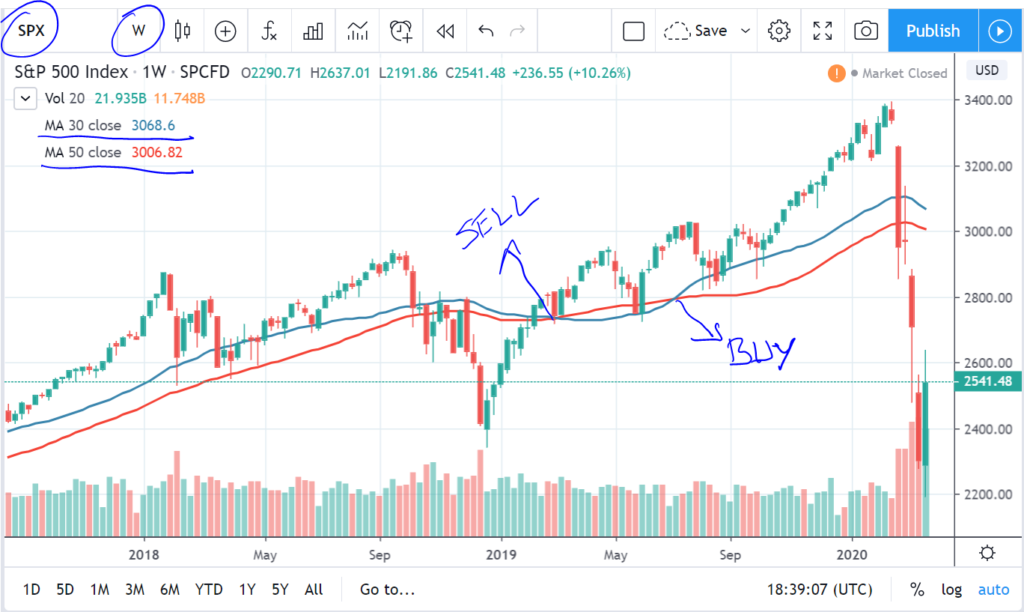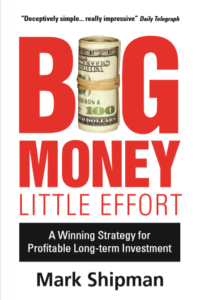I wanted to write a review about Mark Shipman’s “Big Money, Little Effort” as I learnt a lot from this book.
First of all it is a very easy read with only 171 pages. It was published in 2008 however lessons are still valid till this day. Mark Shipman is another fan of index ETF investing but with a little twist to it. Mark is using a technical analysis of Moving Averages to time the market. He is comparing 30 Weeks moving average to 50 weeks moving average.
Rules
- “A‘buy (invest in the stock market)’ signal is active whenever the most recent 30-week moving average figure is greater (higher) than the most recent 50-week moving average figure.”
- A‘sell (savings account investment)’signal is active whenever the most recent 50-week moving average figure is greater (higher) than the most recent 30-week moving average figure.
As you rules are very simple. Let me show you how you can build a graph to view these moving average overlaps.
Use your favorite chart tool whether from your broker or through a website like Tradingview.
Use SPX as the ticker for the chart that equals to US S&P500 Index.
Set the Graph Duration to display W = Weekly.
Under “Indicators\Strategies” choose ‘Moving Averages’
Change length to 30. Add another Moving Average and set that to 50.

Blue line is 30W MA, Red line is 50W MA. When Blue line crosses Red line up then you BUY. For the opposite action you SELL. In a bear market there can be some time before a BUY signal comes again. During this time funds are invested in Fixed Income assets like bonds or fixed deposit.
Mr Axe suggests in investing Fixed Income assets or following The Money Making Machine strategy.
Mark Shipman shows each and every BUY and SELL signal from 1951 to 2007. “As you can see from this historical record, with a total of just 41 signals (21 ‘buy’ and 20 ‘sell’) over the last 56 years, this is a very long-term approach to investing.”
You can see in the graph above in the last 3 years only 2 signals came as I highlighted. It is a very simple strategy follow and a profitable one. You can read more stats in the book. If you are new to Index Tracker Funds, you can learn about them in this book too.
After reading this book I did some research on Mark Shipman’s seminars to find more up to date information. I was also wondering whether people are still following his strategy. My respect to Mark Shipman increased after my research. I highly recommend that you read this book.

Hi Mr Axe,
I’m a bit of a novice to investing and this is the 2nd book I’ve read. I’m 140 pages in and have enjoyed it so far. However when analysing the s&p data from 1951 to 2007 I found that the long term investment strategy as outlined in the book would have returned €403,706 from a €10,000 investment. Whereas a buy and hold strategy would of returned €720,563 from the same €10,000. Surely this would defeat the books strategies purpose? Really I’m hoping that someone can tell me I’ve somehow calculated it wrong because I like the idea of the long term investment strategy. Note that I didn’t factor in the interest that would of been made from an interest bearing savings account, but I don’t imagine that would make up for the €300,000+ shortfall. I’d be interested to hear your thoughts or hopefully someone can tell me how wrong i am haha
Hi Thomas,
The author compared the results in figure 9.4 Page 55. Author’s strategy is to protect investors during downturn in a systematic way. The system generated better results than Buy and Hold therefore the book was created based on these facts.
I personally do not invest according to the principles in this book. If you are a long term investor I recommend you read Book Review: A Random Walk Down Wall Street That book will teach a lot!
I have so far put 3 book reviews and they are all different. One for technical traders, one for long term investors (buy and hold) and this one for Market Timing. You should check all three books and decide which one suits your investment profile more.